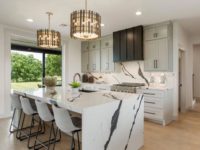Contemporary Stone & Tile Design asked for a manufacturer's perspective on the latest influences and styles. Here is what Davide Saguatti, marketing director of Atlas Concorde USA had to say.
CSTD: What type of tile aesthetic do you find people are currently gravitating towards for their home designs?
DS: After collectively spending much more time indoors and looking to our homes as a place of comfort, it makes sense that consumers are gravitating towards elements of biophilic design. Earthy tones, organic fabrics and furnishings derived of natural materials meet the need to create spaces that provide connectivity to nature. For example, fabric-, wood- and stone-look porcelain tiles in warm taupe and terracotta colors are surging in popularity.
Modern, geometric-shaped accents continue to be very popular as well. We are seeing consumers incorporate hexagons and triangles configured in eye-catching patterns for a contemporary twist on a classic design element.
CSTD: Have these trends shifted at all compared to a few years ago? If so, what do you think are some reasons for this?
DS: There has surely been a transition from an urban industrial aesthetic with robust rich colors and effects towards a look that is much more soothing and calming. After all, many of us are seeking a comforting sense of place, away from the uncertainty of our surroundings. Consumers are seeking looks that feel soft layered and cozy.
CSTD: Are you finding that large-format tiles are still all the rage?
DS: Yes. Bigger is still better for most applications. For example, when installed across a bathroom shower, large-format tiles can give the surround a decadent built-in appearance as there are fewer grout lines in play (which also makes for less upkeep). Even a small room can benefit from an oversized 24- x 48-inch tile, as they can create the optical effect of continuity, making the space feel spacious and open.
CSTD: For what applications do you think tile lines are being used the most?
DS: The U.S. market is still fairly traditional using tile across moisture-prone applications such as bathrooms, showers, backsplashes, countertops, outdoor patios and pools.
A budding design trend is to use tile to create custom accent walls, both in residential (fireplaces, mudrooms and entryways) and commercial applications (hotel lobbies, reception desks).
CSTD: It seems like tile applications are being used more now for outdoor applications than ever before. Why do you think this is?
DS: Landscape designers and consumers are recognizing the aesthetic reliability and performance advantages of utilizing tile in outdoors applications. By nature, porcelain tiles are less subject to scratching, staining, chipping and damaging effects caused by water infiltration, making them an excellent choice for open-air patios, driveways and swimming pool decks. In application, this scenario marries the in-demand aesthetic of nature-inspired materials with porcelain tile’s water-resistant composition to add tactile interest and lasting style to outdoor living spaces.
CSTD: When developing new product lines, what are some factors you consider to determine what is trending now?
DS: During the product development stages, we anticipate emerging design trends by paying close attention to the sizes, decors, mosaics and palettes that are most sought-after by designers.
CSTD: Are there any particular tile trends you are currently seeing in the hospitality and commercial sectors?
DS: While residential markets are leaning into biophilic design, the commercial and hospitality segments are embracing more eclectic and playful elements when it comes to decors and accents. Designers are using larger tile sizes and even other innovative building products in order to make spaces feel truly unique.
CSTD: Overall, what do you see on the horizon in regards to tile trends in the near future?
DS: Tile will continue approaching different destinations of use, as we have seen happen with outdoor applications, as well as with bathroom and kitchen countertops.
Overall, tile’s traditional designation as a floor covering material is permanently shifting thanks to updated industry trainings offered to professionals, which increases awareness with designers and consumers about the wonderful design flexibility and performance advantages of this material.





